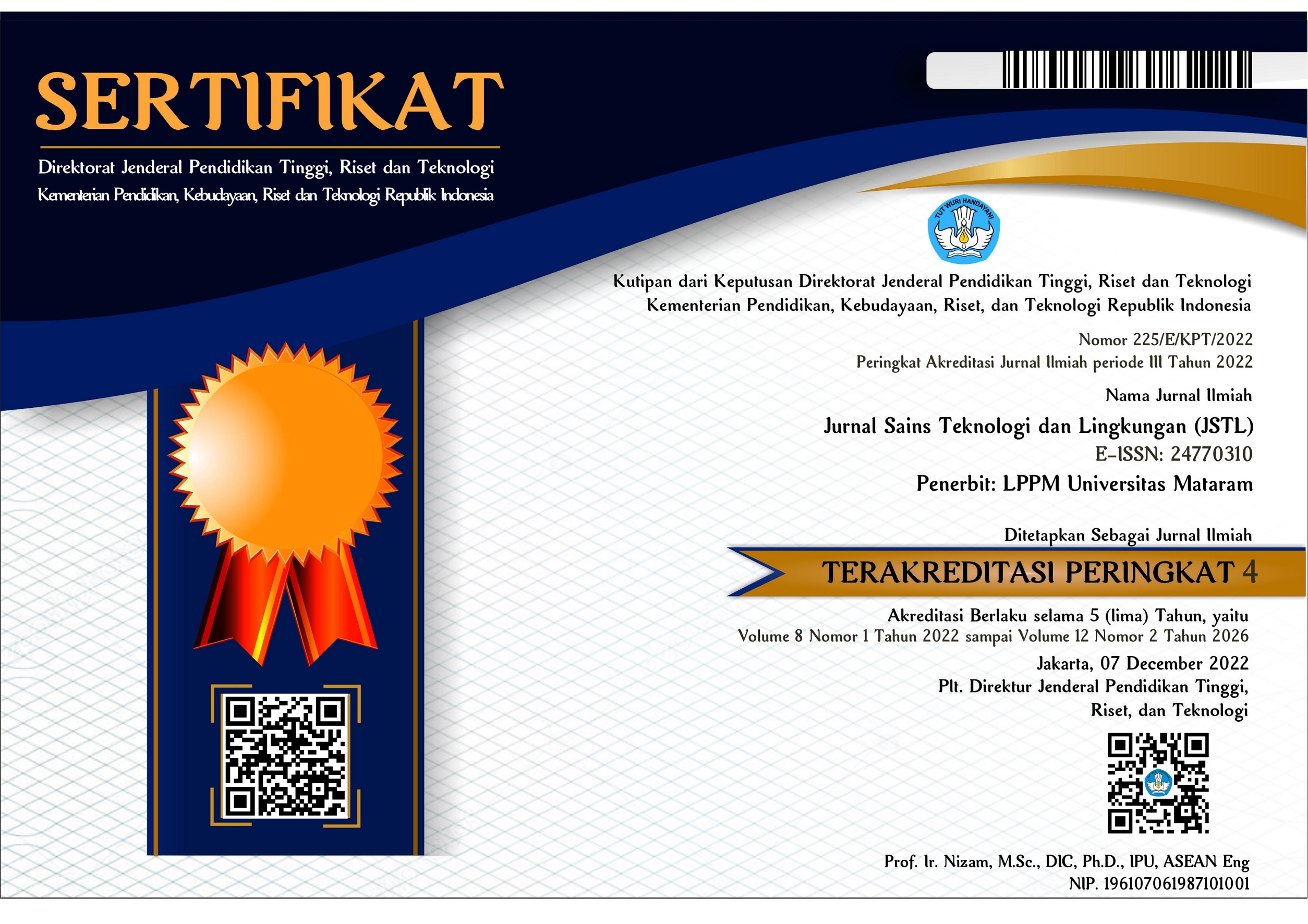Analisis Kinerja Dome Solar Dryer Untuk Pengeringan Kopi Di Desa Karang Sidemen Kabupaten Lombok Tengah
DOI:
https://doi.org/10.29303/jstl.v11i2.735Keywords:
coffee drying, Solar Dome Dryer, direct sunlight, energy efficiency, moisture controlAbstract
Coffee drying is a crucial stage that influences the final product's quality and flavor. This process must be performed correctly to maintain the quality of the coffee beans and prevent mold growth. This study aims to compare two coffee drying methods, using a Solar Dome Dryer and direct sun drying. The research was conducted in Karang Sidemen Village, Central Lombok, using 100 kg of coffee beans, divided into two groups of 50 kg each for the two drying methods. The results showed that both methods successfully reduced the moisture content to 0%, but the drying with the Solar Dome Dryer was faster (4,320 minutes) compared to direct sun drying (4,380 minutes). The Solar Dome Dryer maintained a more stable temperature (50-60°C) and produced a more consistent drying rate, making it more efficient in preserving the quality of the coffee beans and preventing microbial contamination. This study recommends the use of Solar Dome Dryer for coffee drying in areas with high humidity and variable weather conditions.References
Andrade, P. S. de, Duarte, C. R., & Barrozo, M. A. de S. (2024). Improving the quality of Arabica coffee (Coffea arabica L.) through innovative optimization of roto-aerated drying. Innovative Food Science and Emerging Technologies, 96. https://doi.org/10.1016/j.ifset.2024.103770
Atia, A., Teggar, M., & Laouer, A. (2024). Performance of various solar dryer types integrating latent heat storage for drying agricultural products: An up-to-date review. Journal of Energy Storage, 102, 114048. https://doi.org/https://doi.org/10.1016/j.est.2024.114048
Bustos-Vanegas, J. D., Corrêa, P. C., Martins, M. A., Baptestini, F. M., Campos, R. C., de Oliveira, G. H. H., & Nunes, E. H. M. (2018). Developing predictive models for determining physical properties of coffee beans during the roasting process. Industrial Crops and Products, 112, 839–845. https://doi.org/10.1016/j.indcrop.2017.12.015
García-Moreira, D. P., López-Vidaña, E. C., Moreno, I., & Rodríguez-Ortíz, D. (2024). Optical characterization and thermal performance of a novel solar dryer with dynamic control of solar radiation. Case Studies in Thermal Engineering, 61, 105075. https://doi.org/https://doi.org/10.1016/j.csite.2024.105075
Hu, D., Liu, X., Qin, Y., Yan, J., Li, R., & Yang, Q. (2023). The impact of different drying methods on the physical properties, bioactive components, antioxidant capacity, volatile components and industrial application of coffee peel. Food Chemistry: X, 19. https://doi.org/10.1016/j.fochx.2023.100807
Hu, G. L., Quan, C. X., Dai, H. P., & Qiu, M. H. (2024). Characterization of defective coffee beans and blends differentiation based on 1H qNMR technique. Current Research in Food Science, 9. https://doi.org/10.1016/j.crfs.2024.100870
Kokate, Y. D., Baviskar, P. R., & Suryawanshi, S. D. (2024). Performance investigation of newly developed novel hemispherical solar dryer for sustainable food preservation: Comparative analysis with traditional methods. Solar Energy, 283, 113036. https://doi.org/https://doi.org/10.1016/j.solener.2024.113036
Kulapichitr, F., Borompichaichartkul, C., Fang, M., Suppavorasatit, I., & Cadwallader, K. R. (2022). Effect of post-harvest drying process on chlorogenic acids, antioxidant activities and CIE-Lab color of Thai Arabica green coffee beans. Food Chemistry, 366. https://doi.org/10.1016/j.foodchem.2021.130504
Kumar, L., & Prakash, O. (2024). Efficient simulation of bitter gourd drying in active solar dryer: A state-of-the-art model. Renewable Energy, 227, 120434. https://doi.org/https://doi.org/10.1016/j.renene.2024.120434
Severin, H. G., & Lindemann, B. (2024). Elasticity of coffee beans: A novel approach to understanding the roasting process. Journal of Food Engineering, 383. https://doi.org/10.1016/j.jfoodeng.2024.112212
Sharma, M., Atheaya, D., & Kumar, A. (2024). Optimizing hybrid household indirect solar dryer with sinusoidal corrugated Collector: CFD simulations and thermal performance analysis. Solar Energy, 279, 112817. https://doi.org/https://doi.org/10.1016/j.solener.2024.112817
Sharma, N., & Sengar, N. (2024). Experimental Study on Conversion of Blanched Grapes to Raisins Without Chemicals Through Solar Dryer to Reduce Drying Time. Solar Compass, 100098. https://doi.org/https://doi.org/10.1016/j.solcom.2024.100098
Shekata, G. D., Tibba, G. S., & Baheta, A. T. (2024). Recent advancements in indirect solar dryer performance and the associated thermal energy storage. Results in Engineering, 24, 102877. https://doi.org/https://doi.org/10.1016/j.rineng.2024.102877
Urugo, M. M., Tola, Yetenayet. B., Kebede, B. T., Ogah, O., & Mattinson, D. S. (2024). Exploring Arabica Coffee Cup Quality: Correlations with Green Bean Growing Conditions, Physicochemical Properties, Biochemical Composition, and Volatile Aroma Compounds. Journal of Agriculture and Food Research, 101549. https://doi.org/10.1016/j.jafr.2024.101549
YAZICI, M., KOSE, R., & ACER, S. DURMUS. (2024). Investigation of the Comparative Okra Drying Performance of a Geothermal and Solar Hybrid Forced Convection Indirect Type Cabinet Dryer. Renewable Energy, 122031. https://doi.org/https://doi.org/10.1016/j.renene.2024.122031.
Downloads
Published
Issue
Section
License

This work is licensed under a Creative Commons Attribution-NonCommercial-ShareAlike 4.0 International License.


1.png)











